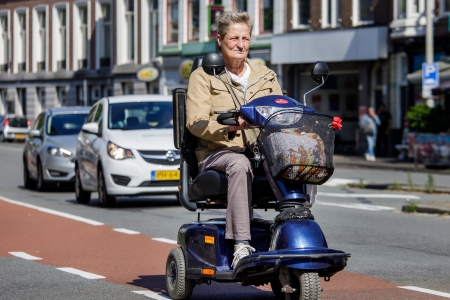This question can only be answered for crashes with mobility scooters and enclosed disability vehicles, since crash statistics do not have a separate category for microcar casualties. Nor are there recent studies specifically focusing on the road safety of microcars.
Age disability vehicle casualties
In the Netherlands, the vast majority of (deceased) casualties among users of mobility scooters and enclosed disability vehicles are older road users.
In 2017-2019, 92% of the road deaths in this group were aged 70 or over, and 68% were aged 80 or over (Figure 4). In 2011, 75% of the mobility scooter casualties treated at an emergency room (ER) were aged 65 or over, almost 50% were aged 75 or over, and 18% were aged 85 or over [10]. Set off against the age distribution of the entire population, the over-85s run the greatest risk of ending up at an ER after a mobility scooter crash.
 Figure 4. Number of road deaths among users of mobility scooters and other disability vehicles by age group in 2017-2019. Source: Statistics Netherlands (Datalink).
Figure 4. Number of road deaths among users of mobility scooters and other disability vehicles by age group in 2017-2019. Source: Statistics Netherlands (Datalink).
Gender disability vehicle casualties
Men are overrepresented in the number of serious outcome crashes; for less serious crashes there are hardly any gender differences.
In 2011, 55% of the mobility scooter casualties treated at an ER were women and 45% were men; considering the population structure, this implies that men and women run almost similar risks of being injured in a mobility scooter crash [10]. An in-depth SWOV study of mobility scooter crashes [5] shows that men are relatively often involved in serious mobility scooter crashes. Statistics Netherlands data confirm this: 77% of the road deaths among mobility scooter users and occupants of enclosed disability vehicles in 2017-2019 were men.
Crash opponents in crashes with disability vehicles
The vast majority of crashes with mobility scooters and enclosed disability vehicles are single-vehicle crashes (falls or collisions with an obstacle). So, these crashes do not involve other road users.
An in-depth study of 35 mobility scooter crashes [5] showed that 21 of them were single-vehicle crashes: the mobility scooter user fell, ended up in the water, or collided with an obstacle such as a kerb.
In the run-up to the crash, other road users were sometimes involved, but through intervention of one or both road users a collision was prevented. However, since this involved a swerving manoeuvre the mobility scooter user took a fall and sustained injuries. In the other 14 crashes, the mobility scooter user did collide with another road user. These crashes involved cars (5x), delivery vans (3x), trucks (3x) and bicycles or other mobility scooters (3x).
A similar picture emerges from the study by Poort et al. [10]. In 2011, 115 casualties treated at an ER filled in a post-treatment questionnaire and 19% of them said to have collided with another vehicle: a car (11%), a bicycle (7%) or a (light) moped (1%). Another 16% said to have collided with an obstacle (e.g. a kerb, tree, fence, wall, or door). The remaining 65% of crashes did not involve a collision.
A different picture emerges when only fatal road crashes are considered. Single-vehicle crashes make up about a quarter (25%) of them, almost half (47%) involve collisions with a car, and slightly less than one fifth (16%) involve a collision with a truck or delivery van (2010-2019; source: Statistics Netherlands).
